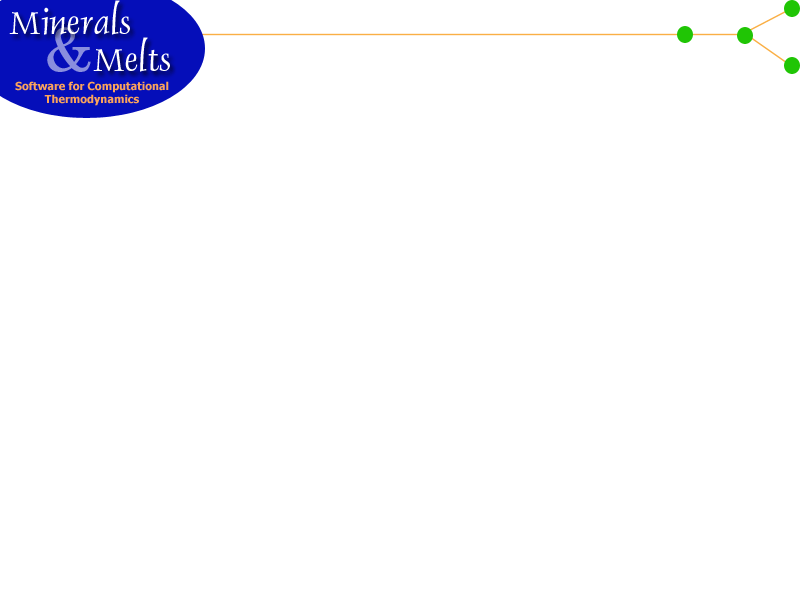Using MELTS to calculate an Equilibrium Crystallization Model along a specified dP/dT gradient
This example demonstrates how to do a simple equilibrium crystallization model along a specified dP/dT gradient using MELTS. It also illustrates how to do partial melting calculations.
- Start MELTS:
- Type the following "bulk mantle" composition into the text entry fields of the liquid composition panel.
SiO2 45.26 TiO2 0.19 Al2O3 3.88 Fe2O3 0.40 Cr2O3 0.41 FeO 7.81 MgO 37.85 CaO 3.57 Na2O 0.30 K2O 0.01
This is done by clicking in the white box to the right of SiO2 (use the left mouse button to select the box) and typing the weight % value. The delete key, arrow keys and mouse may be used to edit the typed value.Typing a return advances the text entry cursor to the next oxide. Continue entering the composition until the liquid composition display panel looks like:
- For convenience, an oxygen fugacity corresponding to the Quartz - Fayalite - Magnetite oxygen buffer (QFM) will be imposed on the system. Select the f O2 Constraint entry of the Intensive Variables menu and while depressing the left mouse button, slide the mouse to the right and down and release on the Q-Fa-Mt constraint buffer entry.
- In the first stage of this model, we will form a mantle partial melt at a pressure of 10 kbars. Using the mouse, pop down the intensive variables menu and release the mouse button of the T,P... menu entry. Fill in the white text entry panels to look like this:
The starting and stopping pressures are set to 10000 bars - the pressure at which we want to determine the composition of the partial melt. The starting and stopping temperatures are set to produce a certain fraction of liquid in the system. Experiment with MELTS to determine the liquid fraction as a function of T for a given bulk composition. In this case, the indicated temperature will result in a partial melt of roughly 15 %. The temperature and pressure increments and dP/dT gradient are unused at this stage of the model and may be left blank.
- Now we are ready to calculate the partial melt by invoking the Exceute/Halt entry of the Commands menu.
- Modeling results are output to the display and to a number of disk files. For information on display elements (including graphs) consult the manual page.
- The model may be halted at any time by invoking the Execute/Halt entry of the Commands menu. The user may change bulk composition or model constraints and restart the calculation using the same menu entry.
- A manual page describes many common numerical problems that may occur when the program is running.
- To verify that the equilibrium state of the system has been achieved, check the status panel display for the phrase:
<> Stable liquid solid assemblage achieved.
The liquid composition panel should look like this:
and the phase proportions and compositions panel should look like this:
- Now, let's model the ascent of a mantle diapir along a particular P/T path assuming (1) local equilibrium between solid and liquid and (2) thermal equilibrium between diapir and surrounding mantle during ascent. Popup the T,P... dialog box from the intensive variables menu and alter the text entries to look like this:
We assume an ascent path stipulated by a dP/dT gradient of 50 bars/K. The diapir begins ascent at a starting temperature of 1387 C and pressure of 10 kbars and stops ascending at 1200 C. At increments of 20 C results will be displayed and written to disk. MELTS will fill in any dependent quantities in the T,P... dialog if the user depresses the compute button. In this case, MELTS fills in the stopping pressure and pressure inc rement:
In general, compute will work with whatever quantities the user has specified and try to calculate any dependent results from these specifications.
- Close the T,P... dialog box and start the model by invoking the Exceute/Halt entry of the Commands menu.
- The results of this simulation are very interesting:
- The system crystallizes during ascent, as might be expected. The final liquid composition:
represents a 3 % partial melts at low pressure.
- What is unexpected, is that during ascent, the system first crystallizes, then back melts, and finally crystallizes again. This can be seen in the liquid composition graph here zoomed in to dis play just the evolution of SiO2:
Points are plotted at intervals of 50 C or 1 kbar. The abscissa records % crystallizes and the ordinate wt % SiO2 in the liquid. The "back-melting" event is terminated by the appearance of plagioclase on the liquidus!
- The system crystallizes during ascent, as might be expected. The final liquid composition:
- The ascent model could have been run in fractionation mode with very different results. Try this yourself.
- Exit the program by invoking the Exit entry of the Commands menu.
